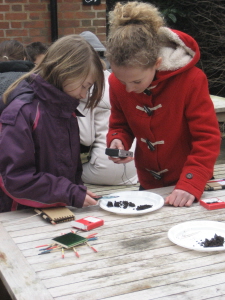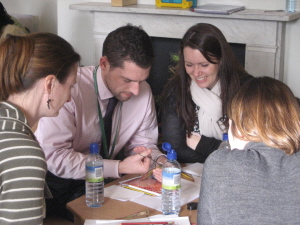Make a donation
Help us make the ordinary extraordinary for children, young people and teachers.
Key Stage 2-3 Transition (10-12)
A transition phase, either from primary to secondary school, or from Key stage 3 to Key stage 4, can be managed effectively if students are introduced to new ways of working in the term before the move takes place. Building strong links between students facilitate the transition from KS2 to KS3 in particular.
 KS2 to KS3 Transition
KS2 to KS3 Transition
The Charles Darwin Trust has developed a series of active learning events that are Darwin Inspired. Transition days support students’ scientific thinking and practical engagement in a way that transcends age related boundaries. Student-centred programmes encourage observation, questioning, theorising, finding evidence in the school grounds, or by internet research and beginning experiments they can complete after the event. Every student is expected to engage in presenting findings in a way that focuses on how they worked like Darwin rather than verifying facts.
Appreciating how Darwin worked as an inspiration for scientific investigation
As a working scientist Darwin made observations, asked questions, designed experiments, used simple equipment including a microscope, measured, repeated experiments and worked with other scientists, gardeners and animal breeders. He recorded his findings in separate notebooks, theorised from evidence, and when working with other scientists from many countries explained what he was thinking in his letters to them. He used models and mind maps to clarify his thinking and linked the evidence he had from many people and experiences that he remembered. He read widely, wrote about his work and published his findings. He was also a family man, and his children assisted him in his experiments on worms, carnivorous plants and pollinating insects.
Transition days are structured around Darwin’s experiments and encourage enquiry-based learning. The school ground or local environment become a living laboratory as students record their observations, thoughts and evidence just as Darwin documented his thoughts and findings, in a notebook. All the activities support learning, self-management, independent enquiry, thinking and reflection, effective participation and team work.
The data generated on these days can be analysed when students begin their first term at secondary school. They engage again with familiar concepts, experiments and ways of working encountered at the transition event. They benefit from recalling how they worked and can ask questions that have occurred to them since.
One teacher commented:
“They loved having a look at [the wormeries] again and were surprised at the amount of soil that had been moved. (The start pictures were invaluable for this part). They were asked to work out in groups how the worms moving of soil would impact on soils in fields – they had loads of ideas. I then reintroduced the [Worm]stone from Darwin’s garden and tried to link the ideas from the class with the experiment he used in his garden.”
 To achieve the greatest impact for students, CDT educators work closely with teachers so that they can make their projects student-centred. Many will be working in a new way and need support in order to let students generate their own questions, work out-of-doors, and find answers for themselves. CDT educators can accommodate whatever environment is available in their school grounds or locally so that it is easier for teachers to follow a thinking path daily or continue an experiment on site.
To achieve the greatest impact for students, CDT educators work closely with teachers so that they can make their projects student-centred. Many will be working in a new way and need support in order to let students generate their own questions, work out-of-doors, and find answers for themselves. CDT educators can accommodate whatever environment is available in their school grounds or locally so that it is easier for teachers to follow a thinking path daily or continue an experiment on site.
We hope in the future to generate useful resources to support teachers to undertake these transition projects themselves. In the meantime, please see our resources for use with Key Stages 2 and 3 that could be adapted for purpose, links below.

